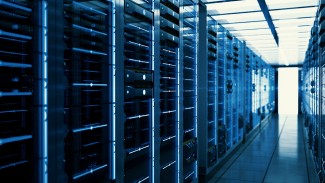Artificial intelligence will either add to the burden on our already-strained electrical grid or we can use it to solve our most complex demand optimization problems, paving the way to a secure energy future. The choice is ours.
It is encouraging to see American homes, vehicles, and new industrial facilities moving away from fossil fuels in favor of clean electricity. A less welcome trend is the rapid growth in electricity demand that the power grid is unprepared for. The proliferation of data centers to meet the growing demand for artificial intelligence (AI) is exacerbating this problem.
Our daily digital lives depend on energy-intensive computing power. When we work in the cloud, shop online, stream TV, use social media, or call a ride, we use electricity. AI models are among the most energy-hungry digital processes we’ve seen in decades. AI offers enormous potential to advance knowledge and convenience and accelerate the digitalization of modern cities, buildings, transportation, farms, and factories. It can also help keep our electricity supply affordable and reliable even as demand surges.
Companies like Google and Microsoft/Open AI are leveraging their procurement power to accelerate advanced clean electricity technologies. Similar efforts have primarily focused on supply-side solutions, such as wind and solar in the immediate future, and eventually advanced nuclear, enhanced geothermal, hydrogen, and long-term storage. These are worthy initiatives, but building more generation and transmission capacity alone cannot resolve the new energy crisis we are facing, at least not within the limited time left for us to combat climate change. All these innovative technologies won’t be widely adopted for decades. In the meantime, our grid will continue to strain under the power demands of AI, electric vehicles, and other electric equipment and devices in a more connected world.
The solution: optimize demand and never waste an electron
Data centers use massive amounts of energy to train and sustain the large language models that enable AI. Energy use by these data centers is already skyrocketing, compounding the strain on an electrical grid ill-equipped to handle our ever-growing electricity demands.
Nevertheless, AI may be our best hope of solving these problems. How? By optimizing both the timing of energy use and the type of energy used. When renewable sources like solar are at their peak, we should do our most energy-intensive work and optimize energy storage. Otherwise, that extra clean energy is curtailed to maintain the power supply and demand balance. For example, in 2023, 2.6 million megawatt hours of utility-scale wind and solar output were curtailed in California—clean energy that could have powered nearly 380,000 California households for that same year.
Energy efficiency has remained the most affordable, fastest-to-deploy energy resource for decades. Increasing the efficiency of the entire electricity system can reduce the need for additional transmission and distribution buildout. Given competing demands on the grid—buildings, transportation, industry—continuously improving system efficiency is an optimization problem of almost infinite complexity; it has too many variables for even a large team of brilliant human engineers to handle. This is where AI comes in: it can accelerate the capabilities of the human intellect, harnessing the power of the best available digital technologies. It can learn how to solve complex energy optimization problems and scale that learning so that we continue to waste less energy and use our available resources more efficiently.
Although our electrical grid is strained during peak demand (e.g., hot summer afternoons), most of the time we actually utilize less than 50% of the grid capacity (including generation, transmission, and distribution). AI could help balance this uneven demand daily, seasonally, and annually, giving us more reliable electricity and reducing carbon emissions by using renewable energy when it has the greatest benefit.
Picture an AI system that dynamically adjusts the speed of manufacturing production lines to align with periods of clean, low-cost electricity while meeting delivery deadlines. Envision an AI-powered platform that plans logistics, minimizing energy consumption while ensuring timely delivery of goods. Imagine an AI-assisted building management system that accounts for local energy generation and consumption patterns while anticipating building occupants’ activities and needs. AI can help all electric customers charge and discharge their energy storage at the most opportune times, maximizing values for their investments and benefits for the grid.
Bridging the technology-behavior gap is vital for optimization
As machine learning, the engine behind today's AI, gained prominence across various disciplines several years ago, the concept of "smart" solutions for energy and sustainability also proliferated: smart grids, smart cities, smart buildings, smart manufacturing, smart devices, and more. The promise of these technologies was immense.
In practice, many of these smart solutions have yet to meet expectations. Their underperformance often stems from a fundamental disconnect between technology and human behavior. While these solutions are technically sophisticated, they usually fail to account for the complexities of human decision-making.
For example, a smart thermostat offers a convenient way to set indoor temperatures lower at night or when occupants are away. However, that thermostat is not intelligent enough to coordinate energy use with other home devices or other buildings in a neighborhood—which may result in a higher peak-time energy demand for the local utility network. In contrast, a simple text alert—“Turn off or reduce nonessential power if health allows, now until 9pm”—from the California Governor’s Office reduced power demand by 1,200 megawatts within minutes to avoid blackouts on a sweltering day in 2022. That text harnessed real human intelligence (and arguably emotion).
In other words, our machines can learn, but they don’t learn like humans. Our new devices may seem "dumb" because they don’t fully align with our intuition or adapt to our behavior. Can AI bridge this gap and truly make these smart solutions intelligent in a human sense? AI’s potential to handle immense complexity is a reason to be optimistic.
Harnessing AI’s potential to ease the energy transition will require intervention and collaboration
With their capacity for intelligent decision-making and advanced data processing and analytics, AI-based tools could revolutionize demand-side solutions by minimizing energy waste without compromising comfort or convenience. However, without intentional policy support, AI investments may prioritize applications that cater to individual consumer interests or encourage people to buy more and consume more, which may exacerbate our energy and climate crises and deepen environmental and social inequities. Look at blockchain, a technology with transformative potential to benefit society that has largely been used for energy-intensive cryptomining. Let’s not let the same thing happen with AI.
For instance, some AI tools can enhance building renderings or let occupants view a future building through augmented reality. AI tools may replace architects and engineers one day to reduce labor costs. But instead of focusing on (or fearing) replacement, we need to incentivize software companies to create AI tools that assist engineers in producing the most efficient and adaptable design solutions—and they can best do this by collaborating with—i.e., learning from—design professionals. Such solutions minimize energy and material usage while ensuring that buildings meet evolving societal needs.
Similarly, AI applications in transportation have predominantly focused on developing autonomous vehicles. Replacing human drivers with machines may benefit some groups, but AI would be more beneficial for nearly everyone if it were used to—i.e., taught to—reduce traffic congestion (travel time and fuel consumption) and ease mobility. AI solutions can revolutionize shipping and logistics by optimizing freight and last-mile deliveries based on multiple factors, including vehicle capacities, charging schedules, and delivery timelines.
AI holds the potential to enhance the effectiveness of smart solutions to optimize energy demand, enhance grid reliability, and accelerate an equitable clean energy transition. It is essential to steer AI development toward solutions that contribute positively to energy efficiency, sustainability, and resilience. This requires proactive policy measures, collaborative partnerships, and a shared commitment to leveraging AI for the collective benefit of society and the planet. While AI is creating a tremendous energy demand challenge, it also holds the key to reducing energy demand far beyond its consumption—but only if we teach it to do so.




